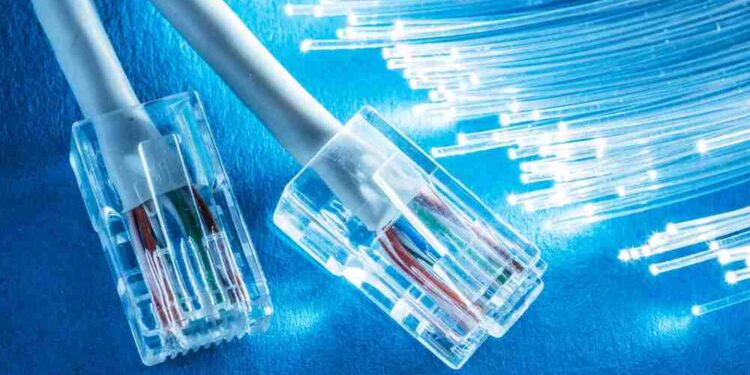Key Takeaways:
- Fiber optic cabling significantly enhances internet speeds, providing businesses faster, more reliable connectivity.
- High-speed internet supports various business operations, including large data transfers, cloud computing, and video conferencing.
- Fiber optic technology offers resilience against electromagnetic interference and weather conditions, leading to improved reliability.
- Upgrading to fiber optic infrastructure is a forward-thinking investment that scales with future technological advancements.
Table of Contents:
- Introduction
- Increased Internet Speeds with Fiber Optic Cabling
- Boosted Reliability through Network Cabling & Wiring
- Enhancing Business Operations and Productivity
- Conclusion
Introduction
In today’s digital age, a fast and reliable internet connection is essential for business operations. From small companies to large enterprises, the ability to transmit data quickly and efficiently can significantly impact productivity and success. One of the most effective ways businesses can achieve superior internet speeds is through fiber optic cabling. This advanced technology offers numerous benefits, making it an ideal solution for companies looking to enhance their digital infrastructure and stay competitive in an increasingly interconnected world.
The demand for high-speed internet has never been greater, driven by the proliferation of data-intensive applications and the rise of remote work. With fiber optic cabling, businesses can meet these demands, ensuring their digital infrastructure can handle present and future requirements.
Increased Internet Speeds with Fiber Optic Cabling
Fiber optic cabling is renowned for its ability to provide lightning-fast internet speeds, significantly outpacing traditional copper cabling systems. Conventional copper cables often need help with bandwidth limitations and signal degradation over long distances, resulting in slower data transfer rates and inconsistent connectivity. In contrast, fiber optic cables use light signals to transmit data, enabling significantly higher speeds and greater capacity.
This ability to handle large volumes of data at incredible speeds makes fiber optic cabling a game-changer for businesses. Whether supporting real-time video conferencing with clients across the globe, managing large data sets, or running complex applications, the enhanced bandwidth of fiber optic cables ensures that operations can proceed without any lag or disruptions. Speed translates to efficiency, and efficiency translates to better productivity and profitability.
Moreover, fiber optics’ upload and download speeds are symmetrical, meaning businesses can upload large files and back up data to the cloud as quickly as they can download information. This balanced performance is crucial for sectors that rely on heavy data exchange, such as media production, financial services, and research and development. By investing in fiber optic technology, businesses can remain agile and responsive, capable of meeting the demands of a digital-centric world.
Boosted Reliability through Network Cabling & Wiring
Reliability is a critical factor for businesses when it comes to internet connectivity. Poor reliability can lead to dropped connections, slow data transfer, and lost productivity and revenue. With fiber optic network cabling & wiring, businesses can enjoy a significant boost in reliability. Unlike traditional copper cables, fiber optic cables are less susceptible to electromagnetic interference, ensuring a stable and consistent connection even in environments with a high concentration of electronic devices.
Electromagnetic interference from machinery, power lines, and other electronic equipment can disrupt signals in copper cables, leading to data loss and reduced performance. On the other hand, fiber optic cables are immune to such interference, maintaining signal integrity and consistency. This characteristic makes fiber optic cabling particularly beneficial for industrial environments and data centers, where reliable connections are vital for smooth operations.
Moreover, fiber optic cables are less affected by adverse weather conditions. Traditional copper lines can suffer from signal degradation due to moisture, extreme temperatures, and other environmental factors. However, fiber optics are more durable and resistant to these elements, reducing the likelihood of service interruptions caused by weather-related issues. The result is a more dependable internet connection, which is crucial for businesses that rely on continuous online operations.
Enhancing Business Operations and Productivity
High-speed internet is more than just a convenience; it’s a fundamental component of modern business productivity. With fiber optic cables, companies can support a wide range of operations that rely on fast and reliable internet connectivity. For example, cloud computing services, which allow businesses to store and access data remotely, perform much better with high-speed connections. Employees from different locations can collaborate seamlessly using real-time applications, improving overall efficiency and productivity.
Additionally, fiber optic internet supports advanced technologies, ensuring crystal-clear communication and seamless video conferencing. This capability is significant for businesses with remote teams or multiple office locations, as it facilitates smooth and effective communication. The ability to conduct high-quality video meetings without lag or interruptions enhances collaboration, decision-making, and the overall flow of information within the company.
The increased bandwidth provided by fiber optic cabling also supports data-intensive applications and tools. For instance, graphic design, media production, and engineering businesses often require transferring large files and using complex software. High-speed internet makes these processes faster and more efficient, saving valuable time and resources. Businesses can stay competitive, innovative, and productive in an ever-evolving digital landscape by optimizing their digital infrastructure with fiber optic technology.
Conclusion
Fiber optic technology offers numerous advantages for businesses seeking to enhance their internet speeds, reliability, and overall digital infrastructure. By adopting fiber optic cabling, companies can experience faster data transfer rates, improved connectivity, and greater resilience against environmental factors. These benefits translate to increased productivity, collaboration, and competitiveness in a rapidly changing digital landscape.
As the demand for high-speed internet continues to grow, investing in fiber optic technology is a strategic decision that positions businesses for future success. Whether supporting advanced applications, improving communication, or ensuring a reliable internet connection, fiber optic cabling provides the foundation to thrive in the digital age; businesses can unlock new possibilities, drive innovation, and achieve sustainable growth in an increasingly interconnected world by making this investment.
















